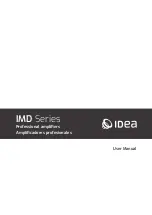
14
A FEW TECHNICAL THINGS TO REMEMBER
Clipping = Bad
– Keep an eye on the EQ Clip light. If it blinks, either
reduce Input Gain or cut back on one or more EQ ranges. As we said earlier,
Clipping in the preamp section is a
Very Bad Thing
and is to be avoided at
all times. If you find yourself running out of amplifier headroom, cut a little
in the lower frequencies, which require the most power from your amp.
You’ll know this is happening if you see the Limit light flashing. As long as
the light is just blinking, you’re fine. But, if it’s on more than it’s off, you
might want to back off a bit.
Frequency Oddities
– Two areas are a frequent source of frustration for
bassists trying to achieve their sound: frequency masking and frequency
enhancement. Frequency masking occurs when other instruments
(particularly cymbals and electric guitars) obscure the important upper
harmonic content of your sound. As a result, you find that the EQ settings
that were so perfect at home lack definition in a live setting. On the other
hand, the stage settings that worked so well sound harsh and/or thin in the
absence of other instruments.
Frequency enhancement results from cabinet placement and room acoustics.
A cabinet placed on the floor will have the lower frequencies boosted by
about 3 dB. Placement against a wall adds another 3 dB. A corner adds 3 dB
more. Consequently you may find a surprising boominess to your sound.
Certain qualities in the room itself can also enhance the lower frequencies,
further contributing to this problem. Frequently this effect is more noticeable
in the audience than it is on stage. Compensating for it may result in a stage
sound that may seem a little thin. However the sound is actually quite full
out in front.
NOTE
; Remember, you can’t equalize out major physical room anomalies.
If things sound really weird where you are, try moving you rig a few feet
and see if that helps. This may be particularly helpful on saggy stages that
bounce like a drum head. (
The propellerhead term for this is
“diaphragmatic.” So says David. – LB
)




































